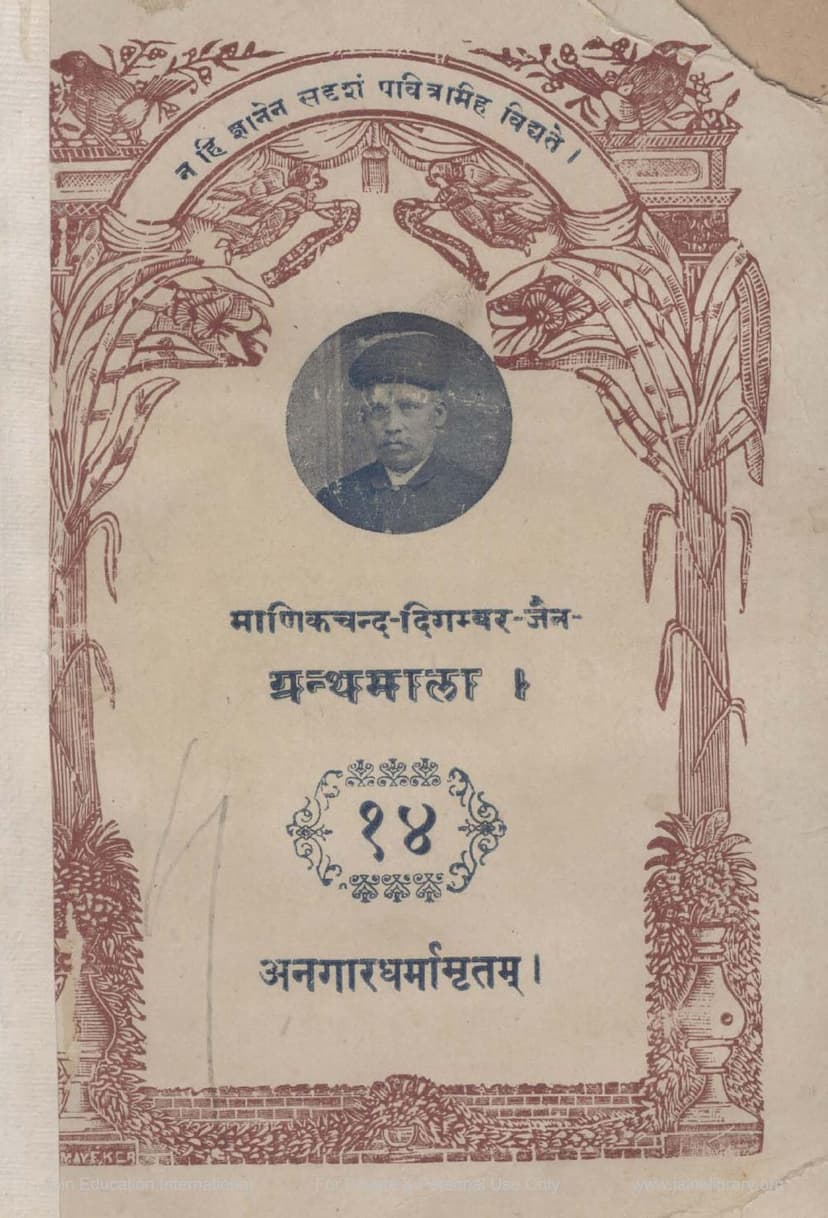Anagar Dharmamrutam
Added to library: September 1, 2025

Summary
This is a comprehensive summary of the Jain text "Anagar Dharmamrutam" by Ashadhar, with commentaries, as indicated by the provided catalog link and page fragments. The text delves deeply into the principles and practices of monastic (Anagar) Jainism.
Anagar Dharmamrutam: A Comprehensive Summary
"Anagar Dharmamrutam" (The Ambrosia of Monastic Conduct) is a seminal Jain text authored by Acharya Ashadhar, a revered Digambar Jain scholar of the 12th century. The work, with its commentary "Bhavya Kumud Chandrika," meticulously details the conduct and vows of Jain monks, presenting a profound spiritual guide for ascetics. The text is structured into several chapters, outlining the path to liberation through rigorous adherence to Jain principles.
Key Themes and Chapters:
The text systematically explores the spiritual journey of a Jain monk, covering various essential aspects of their ascetic life. The chapter titles, as glimpsed from the page fragments, indicate a structured progression through the core tenets of Jain practice:
-
Dharmaswaroop Nirupana Adhyaya (Chapter on the Nature of Dharma): This foundational chapter likely defines the essence of Jainism and its core principles, setting the stage for the subsequent discussions on conduct. It emphasizes the importance of right faith (Samya,kdarshan), right knowledge (Samya,kgyan), and right conduct (Samya,kcharitra) as the path to liberation.
-
Samyakttvonipadanaadikram Adhyaya (Chapter on the Production of Right Faith): This chapter is dedicated to the process of attaining and cultivating right faith (Samya,kdarshan), which is the bedrock of Jain spiritual practice. It likely discusses the necessary steps and conditions for developing this crucial aspect of the path.
-
Gyanaradhana Adhigama Adhyaya (Chapter on the Attainment of Right Knowledge): Following the establishment of right faith, this chapter focuses on the pursuit and attainment of right knowledge. It likely elaborates on the different types of knowledge (Mati, Shruta, Avadhi, Mano-paryaya, Keval) and the methods for their acquisition through study, contemplation, and the grace of enlightened beings.
-
Samyakcharitraaradhaniya Adhyaya (Chapter on the Worship of Right Conduct): This chapter delves into the practical application of right conduct, which for monks involves the strict observance of vows and disciplines. It likely details the vows of non-violence (Ahimsa), truthfulness (Satya), non-stealing (Asteya), celibacy (Brahmacharya), and non-possession (Aparigraha), along with their ancillary practices and the severe austerities undertaken by monks.
-
Pindashuddhi Vidhaniya Adhyaya (Chapter on the Purification of Alms and Sustenance): This chapter specifically addresses the conduct related to the monk's alms-round and sustenance. It emphasizes the strict rules regarding the collection of food, the types of food that can be accepted, and the meticulous purification processes to ensure no harm comes to any living being.
-
Margamahodyoga Varnaniya Adhyaya (Chapter on the Path and Effort): This chapter likely focuses on the continuous effort (Yoga) required by the monk on the spiritual path. It probably details the diligent practice of meditation, contemplation, and the overcoming of obstacles that arise during the ascetic journey.
-
Tapasyaaraadhana Vidhaniya Adhyaya (Chapter on the Worship of Austerities): Austerities (Tapas) are central to Jain monasticism, serving as a means to burn away karma. This chapter would meticulously describe the various forms of austerities, both internal (mental) and external (physical), and their importance in spiritual purification.
-
Aavashyak Niryuktaabhidhaniya Adhyaya (Chapter on the Essential Duties): This chapter, as indicated by the term "Aavashyak," likely details the essential daily rituals and practices incumbent upon a monk. This would include meditation, scripture study, contemplation of vows, and other prescribed routines necessary for maintaining spiritual discipline.
Commentary and Authorship:
The text is attributed to Acharya Ashadhar, a highly influential figure in Digambar Jain tradition. The presence of "Khopagya Bhavya Kumud Chandrika Teeka Sahitam" indicates a detailed commentary by Ashadhar himself, likely explaining the intricacies of the original text. The work was further edited and revised by Pandit Bansidhar Shastri and Pandit Manoharlal Shastri, signifying its scholarly importance and effort towards textual accuracy. The publication by Manikchand Digambar Jain Granthamala Samiti highlights its role within the dissemination of Digambar Jain scriptures.
Core Principles Embodied:
- Ahimsa (Non-violence): As a foundational principle, Ahimsa would permeate the entire text, guiding the monks' conduct in thought, word, and deed, especially in relation to alms and daily activities.
- Asceticism: The book emphasizes the rigorous lifestyle of monks, including celibacy, non-possession, and severe austerities, all aimed at detachment from worldly pleasures and the eradication of karmic impurities.
- Spiritual Knowledge and Faith: The text underscores the interconnectedness of right faith, right knowledge, and right conduct, detailing how the latter two are cultivated and sustained by the former.
- Mindfulness and Self-Control: The importance of controlling the senses and the mind, through practices like meditation and contemplation, is a recurring theme, essential for spiritual progress.
- Karma Theory: The underlying principle of karma and its influence on the soul's journey is implicitly or explicitly addressed, with the ultimate goal being the cessation of karmic influx and the attainment of liberation.
In essence, "Anagar Dharmamrutam" serves as a comprehensive manual for Jain monks, providing a detailed and authoritative guide to living a life of extreme detachment, purification, and spiritual discipline, all aimed at achieving the ultimate goal of liberation.